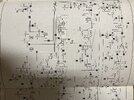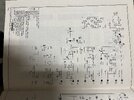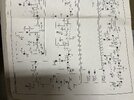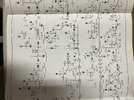I recently acquired for free, a Teaberry T Bear radio. It had no audio RX and TX. I found a few bad solder joints and after re-flowing them I got the RX and TX audio working. Now whenever I key the radio (dummy load) it is quite until I give it any audio at all then I get a squeal that sounds like RF in the audio chain. The squeal disappears/gets covered up while modulating. If anyone has any suggestions or a manual/schematic I would be grateful.
You are using an out of date browser. It may not display this or other websites correctly.
You should upgrade or use an alternative browser.
You should upgrade or use an alternative browser.
-
You can now help support WorldwideDX when you shop on Amazon at no additional cost to you! Simply follow this Shop on Amazon link first and a portion of any purchase is sent to WorldwideDX to help with site costs.
Old Teaberry "T Bear" squealing during tx.
- Thread starter Allen B
- Start date
Maybe someone here has sams cb-155.
Without a schematic, all I can do is guess, but it sounds like the mic switch is not disconnecting the speaker during TX. Try with headphones. You will still hear yourself due to the switch not working (if thats what it is) but it shouldn't squeal. Wrong mic???
Without a schematic, all I can do is guess, but it sounds like the mic switch is not disconnecting the speaker during TX. Try with headphones. You will still hear yourself due to the switch not working (if thats what it is) but it shouldn't squeal. Wrong mic???
It's not coming from the radios speaker. The squeal is in the transmit rf audio. I put the radio on the air and listened through a SDR. Funny thing is you can key the radio and it puts out a clean carrier, it's only after it gets a small amount of audio in the mic that the squealing starts. It really seems like something is feeding back inside the radio itself. Other than the squeal the audio actually sounds good.
If the dummy load is good and the issue is not being caused by high SWR, try adding an ferrite bead to the mic audio line. Amidon has FB-73-101's for $0.60 each.
Edit: use two or three
Edit: use two or three
Thanks alot. That will definitely be of some help.Here is the T Bear schematic from CB-155.
Good Luck.
73
David
Umm, dare I say it? Electrolytic capacitors. Start with the biggest one, C119. It serves to filter the radio's main DC power. Schematic shows a 470uf. I would use a 1000uf. Larger wouldn't hurt, so long as it won't bump into the inside of the cabinet.
Next two likely suspects serve to filter the juice that powers the mike preamp/compressor chip. C159, 100uf and C127, 10uf.
It's old enough to qualify for a Klondike Mike re-cap kit.
Mileage affects this, and without an odometer this is tough to pin down. A low-mileage radio might have only one or two electrolytic caps gone bad.
This week.
The higher the mileage, the bigger the electrolytic death toll as a rule.
Might have another cause, like a loose ground screw on the pc board, but the odds favor one or more failed electrolytics.
73
Next two likely suspects serve to filter the juice that powers the mike preamp/compressor chip. C159, 100uf and C127, 10uf.
It's old enough to qualify for a Klondike Mike re-cap kit.
Mileage affects this, and without an odometer this is tough to pin down. A low-mileage radio might have only one or two electrolytic caps gone bad.
This week.
The higher the mileage, the bigger the electrolytic death toll as a rule.
Might have another cause, like a loose ground screw on the pc board, but the odds favor one or more failed electrolytics.
73
When I mess with it next, I am going to remove those and test them. I do believe this radio spent a lot of time on, but not transmitting. It was installed as a base years ago.Umm, dare I say it? Electrolytic capacitors. Start with the biggest one, C119. It serves to filter the radio's main DC power. Schematic shows a 470uf. I would use a 1000uf. Larger wouldn't hurt, so long as it won't bump into the inside of the cabinet.
Next two likely suspects serve to filter the juice that powers the mike preamp/compressor chip. C159, 100uf and C127, 10uf.
It's old enough to qualify for a Klondike Mike re-cap kit.
Mileage affects this, and without an odometer this is tough to pin down. A low-mileage radio might have only one or two electrolytic caps gone bad.
This week.
The higher the mileage, the bigger the electrolytic death toll as a rule.
Might have another cause, like a loose ground screw on the pc board, but the odds favor one or more failed electrolytics.
73
dxChat
- No one is chatting at the moment.
-
-
dxBot:63Sprint has left the room.
-
dxBot:kennyjames 0151 has left the room.
-
-




